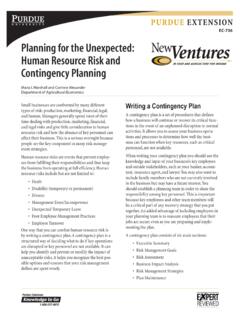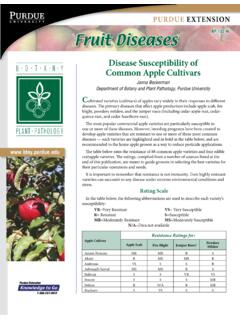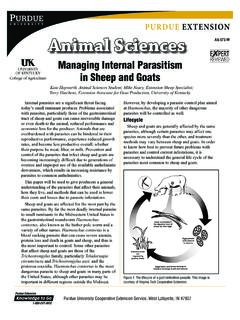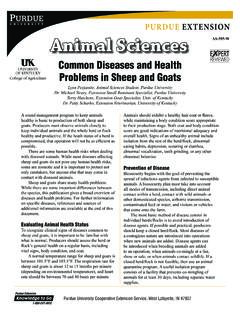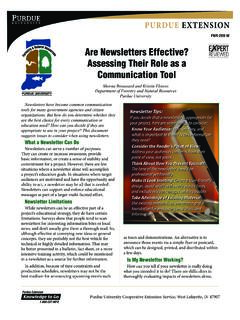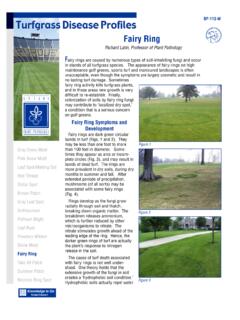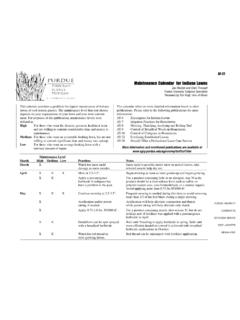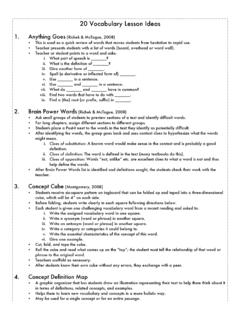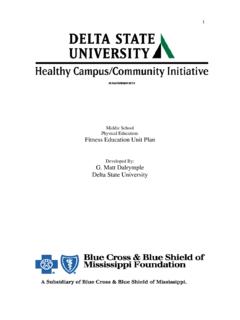Transcription of Healthy Body Image: A Lesson Plan for High School Students
1 Purdue Extension Consumer & Family Sciences CFS-737-W. Healthy body image A Lesson plan for high School Students Steven P. McKenzie, Continuing Lecturer/Interim Administrator Ismail Center for Health, Exercise, and Nutrition Purdue Department of Foods and Nutrition Purdue Department of Health and Kinesiology There are three companion pieces to this publication: The main sections of this publication are: CFS-738-W, Healthy body image : Background for Facilitators, p. 2. Healthy Exercises for Every body Activity 1: Celebrate Your Unique Qualities This 17-page publication explains and illustrates various Facilitator's Notes, p. 4. cardiorespiratory, flexibility, and resistance exercises.
2 It also discusses who should get a doctor's advice before Discussion Outline, p. 5. beginning an exercise program, lists exercises to avoid, Activity 2: Mixed Messages: and outlines recommended lifting techniques. Living in a Supersized World CFS-735-W, Healthy body image : Facilitator's Notes, p. 6. Being an Advocate for Your Child or Grandchild Discussion Outline, p. 7. Advertising Questionnaire This 15-page publication contains four main sections: Handout, p. 9. 1) understanding weight-related concerns; 2) role modeling a Healthy body image ; 3) providing a Healthy Activity 3: Healthy Eating in environment; and 4) recognizing signs of a possible a Nutshell eating disorder.
3 Facilitator's Notes, p. 10. CFS-736-W, Healthy body image : Discussion Outline, p. 10. A Lesson plan for Middle School Students Activity 4: An Ounce of Exercise Keeps the Doctor Away This 17-page publication provides background infor- Facilitator's Notes, p. 13. mation, a Lesson plan outline, plus four activities and Discussion Outline, p. 14. handouts to teach groups of young teenagers that society often places an unhealthy emphasis on an idealized body image . It teaches that eating nutritious foods and being physically active are the keys to good health.. Healthy body image .. Lesson plan for high School Students Background for Facilitators The materials in this four-activity unit on Healthy body image are intended for use with high School participants.
4 A separate publication lists activities for middle School participants. Activities 1 and 2 are different, based on the intended age level, but the rest of the materials are the same for both age groups. Each activ- ity begins with notes for the facilitator, followed by an outline for a discussion on that topic and, in Activity 2, a master copy of a handout. You will have to provide magazine ads for Activity 2, and you may want to provide copies of CFS-738-W. for each participant as part of Activity 4. What follows here is some general back- ground information about body image . Few things are more central to our long-term health and happiness than how we view ourselves. Our body image is a vitally important part of our self- image .
5 Our perception of our body often is influenced by how we think others view us. Many people feel driven to comply with their perception of how society expects them to look. Not meeting these expectations frequently places people in a state of conflict that results in reduced self-esteem and leads to unhealthy diet and exercise prac- tices. The unhealthy practices commonly associated with body image issues may lead some people to become extremely underweight, while others become over- weight or obese. Issues involving body image are present in all age groups and both genders in our society. A Healthy body image should be a goal of everyone, regard- less of his or her circumstances.
6 Today, we know a great deal about how lifestyle behaviors (including good nutri- tion and physical activity) can help us stay Healthy (ACSM, 2006, USDA, 2005a). Unfortunately, knowledge alone is not enough to motivate most people to adopt a Healthy lifestyle. The number of teenagers who are overweight has risen steadily over the past two decades. In Indiana, 15 percent of teenage respondents to the Youth Risk Behavior Survey conducted by the Centers for Disease Control and Prevention were overweight in 2005, up from percent just two years earlier (Indiana State Department of Health, 2005a). The actual number of Hoosier teens who are overweight contrasts dramatically with the percentages who describe themselves as overweight (the reality versus perception gap), as illustrated in Table 1.
7 Table 1 illustrates that a significantly high number of teens view themselves as overweight whether they actually are or not. This is especially true among females. Table 1. An even more exaggerated Indiana Teens: Actual Versus Perceived Overweight 2005 contrast between reality and Actual Percent Percent Describing perception is apparent when Overweight Themselves as Overweight we compare the self-reported (Data from: ISHD, 2005a). Both genders diet and exercise behaviors Males of Hoosier teens with their Females actual overweight status (see Table 2 on next page).. Purdue Extension CFS-737-W. Healthy body image .. Lesson plan for high School Students Table 2. Table 2 illustrates that there Indiana Teens and Weight Loss-Related Behaviors is clearly something other Actual Percent Currently Trying Through Through Overweight to Lose Weight Exercise Diet than being overweight that is (Data from: ISHD, 2005a).
8 Both causing teens to be dissatisfied genders with their body and moti- Males vating them to use diet and Females exercise to accomplish their perceived need for weight loss. Since many Indiana teenagers state that they are using diet and exercise to reach their weight loss goals, one might ask, Are they dieting and exercising in line with current national recommendations? One key recommendation for weight man- agement is to consume the recommended amounts of fruits and vegetables each day (USDA, 2005b). The CDC survey asked Indiana teens whether they ate at least five fruit and vegetable servings per day. Eighty-four point five percent of Hoo- sier teens surveyed in 2005 said they did not (ISHD, 2005a).
9 Milk consumption is another important dietary indicator. The 2005 survey reports that percent of Indiana teens report drinking at least the recommended three 8-ounce glasses of milk per day (ISHD, 2005a), suggesting that percent do not. Also high on the list of concerns about the diet practices of Hoosier teens is that percent of them say that they take diet pills or use powder or liquid weight loss aids without consulting a physician. Another percent admit to vomiting or using laxatives as weight loss strategies (ISHD, 2005a). Clearly, a gap exists between what experts consider to be Healthy and the diet and weight loss strategies actually used by Indi- ana teens. So what about exercise?
10 According to the 2005 Youth Risk Behavior Survey, percent of Indiana teens report receiving an adequate amount of physical activity based on the recommended standards of Healthy People 2010 (ISHD, 2005b). On the flip side, percent of Indiana teens report watching at least three hours of television per day on a typical School day, and percent state they engage in no regular physical activity. Clearly, a significant portion of Indiana teens can benefit from clearly understanding the recommended quantities of Healthy exercise and the role of exercise in weight management. Teenagers in Indiana, as elsewhere, appear to feel a significant amount of pressure to conform to their perception of how society wants them to look.
